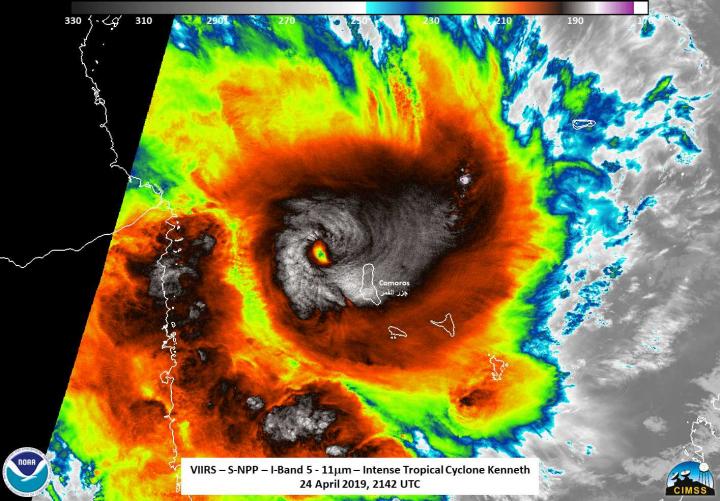
Credit: NASA/NOAA/ University of Wisconsin – Madison, SSES-CIMSS, William Straka III
Mozambique is still recovering from deadly Tropical Cyclone Idai, and a second powerful tropical cyclone has now made landfall in the country. As NASA-NOAA’s Suomi NPP satellite passed over the Southern Indian Ocean, it captured an infrared image of Tropical Cyclone Kenneth making landfall in northern Mozambique.
Tropical Cyclone Idai made landfall on April 15 in central Mozambique. It caused catastrophic flooding, landslides, and large numbers of casualties across Mozambique, Malawi, and Zimbabwe.
Intense Tropical Cyclone Kenneth made landfall today, April 25, in northern Mozambique. It was likely the strongest storm on record in northern Mozambique, equivalent to a weak Category 4, strong Category 3 storm on the Saffir-Simpson Hurricane Wind Scale. Kenneth has also made history simply by the fact that Mozambique has never been hit by back-to-back storms.
Over night of April 24 and 25, intense Tropical Cyclone Kenneth was observed by three satellites including Suomi NPP, NOAA’s NOAA-20 and the GCOM-W1 satellite. Each provided several unique points of view of the storm. On April 25 at 0000 UTC (April 24 at 8 p.m. EDT) The Regional Specialized Meteorological Centre or RSMC at La Reunion Island stated that Kenneth had winds of 105 knots (121 mph/194 kph), which would have meant at the time it was the equivalent to a Category 3 storm. By 2 a.m. EDT (0600 UTC), the Joint Typhoon Warning Center had satellite derived winds of 125 knots (144 mph/213 kph).
William Straka III, a Researcher at the University of Wisconsin – Madison Space Science and Engineering Center (SSEC) Cooperative Institute for Meteorological Satellite Studies (CIMSS) created imagery using the NASA-NOAA Suomi NPP satellite data. “Kenneth was first observed by Suomi-NPP at 5:24 p.m. EDT (2142 UTC) on the edge of the pass as it was to the northwest of Comoros. The infrared imagery showed features that are typical of an intense tropical system with overshooting cloud tops and convectively driven tropospheric gravity waves.”
Between the time Suomi NPP passed overhead and the NOAA-20 polar orbiting satellite passed over the region, the eye appeared to clear. In addition, the Advanced Technology Microwave Sounder (ATMS) instrument aboard the NOAA-20 satellite looked at the inner structure of the storm. The ATMS microwave imagery showed powerful thunderstorms completely surrounded the eye of the storm.
By 11 a.m. EDT (1500 UTC) on April 25, Kenneth was still making landfall in northeastern Mozambique. It was centered near 12.1 degrees south latitude and 50.8 east longitude. That is about 150 miles west of Comoros Island. Kenneth was moving to the west-southwest and had maximum sustained winds 120 knots (138 mph/222 kph).
The JTWC forecaster said the system will rapidly weaken over land, but the remnants may re-emerge over the Mozambique Channel after a few days.
By Rob Gutro
NASA’s Goddard Space Flight Center
###
Media Contact
Rob Gutro
[email protected]
Original Source
https:/



